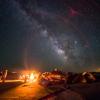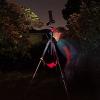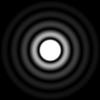
120ST - Diminished Light Cone?
Started by
Hawksbill
, Feb 02 2009 09:44 PM
3 replies to this topic
#1

Posted 02 February 2009 - 09:44 PM
I recently purchased an Orion 120ST. It has been very cloudy here in SE Michigan and although I have the OTA and an AT Voyager alt/az mount (and a cheap 25mm eyepiece), I am still waiting for clear skies and for the 13mm Ethos to arrive.
This has given me a bit of time to inspect it, fiddle with things and read old CN threads about the 120ST.
One thing I noticed while inspecting the tube is that, while looking through the objective towards the focuser, I can only see the eyepiece hole from the center area of the objective. If I lean off to one side and look down the tube from the edge of the objective lens, it appears that the focuser tube cuts into the light cone and prevents a lot of light from reaching the eyepiece.
I vaguely remembered this subject in an old thread and found it here.
So, it appears that the entire 120mm of objective lens is NOT providing light down through the focuser to the eyepiece. I haven't measured it exactly, but it appears that a couple of centimeters is cut off from the outside edge of the objective.
Have other 120ST owners noticed this? Have I really just purchased an 80mm or 90mm scope without realizing it? If this is correct, how can I fix it?
One thing that comes to mind is that a replacement focuser (which I was already planning on purchasing) may solve the problem.
Do any of you who have a 120ST and have replaced the focuser with a GSO, WO or Moonlite notice the same problem?
Are there any owners of the smaller 100ST who have noticed a similar issue?
This has given me a bit of time to inspect it, fiddle with things and read old CN threads about the 120ST.
One thing I noticed while inspecting the tube is that, while looking through the objective towards the focuser, I can only see the eyepiece hole from the center area of the objective. If I lean off to one side and look down the tube from the edge of the objective lens, it appears that the focuser tube cuts into the light cone and prevents a lot of light from reaching the eyepiece.
I vaguely remembered this subject in an old thread and found it here.
So, it appears that the entire 120mm of objective lens is NOT providing light down through the focuser to the eyepiece. I haven't measured it exactly, but it appears that a couple of centimeters is cut off from the outside edge of the objective.
Have other 120ST owners noticed this? Have I really just purchased an 80mm or 90mm scope without realizing it? If this is correct, how can I fix it?
One thing that comes to mind is that a replacement focuser (which I was already planning on purchasing) may solve the problem.
Do any of you who have a 120ST and have replaced the focuser with a GSO, WO or Moonlite notice the same problem?
Are there any owners of the smaller 100ST who have noticed a similar issue?
#2

Posted 03 February 2009 - 05:02 AM
My way to check whether the light cone is blocked is to put 3 slightly inward protruding marks(such as a cut sticker, sticking out very little, say, 0.5mm to the aperture center, with 120 degree betwee each) on the edge of the front ring of the lens , then you place your eye where the eyepiece is placed (diagonal in place)and look at the lens. If you can see all the 3 tips of the mark, then don't be worried. the blocked aperture is less than .5mm, otherwise you have to do something to reclaim the lost aperture.
Kurt
Kurt
#3

Posted 03 February 2009 - 06:27 AM
Ya, I suggest you look either through the diagonal, or just straight through the focuser. Can you see the entire objective lense? If so, then the whole light cone should be going to the EP. I have the 100mm, 600mm fl and I can indeed see the entire objective from the diagonal.
#4

Posted 03 February 2009 - 09:24 AM
Ya, I suggest you look either through the diagonal, or just straight through the focuser. Can you see the entire objective lense? If so, then the whole light cone should be going to the EP. I have the 100mm, 600mm fl and I can indeed see the entire objective from the diagonal.
Not so, the way you suggest will show severe image cutoff if the end of the focuser is cutting into the light cone so severely that not only would part of the objective edge not be seen from the edge of the user end of the focuser drawtube or the end of the diagonal but also from the drawtube or diagonal center. However as the original poster said he can see the center of the opening at the distal end (user end) of the drawtube from the edge of the objective. That being so, if you have your eye positioned correctly in the center and your exit pupil is down in the 2 to 4 mm range, maybe less, considering that you are doing this testing in daylight, it stands to reason that you will see all of the circumference of the objective from this position. This does not mean however that the focal plane is being fully illuminated - either for a wide field 1.25" format eyepiece, 2" eyepiece, camera film plane, or digital or ccd camera focal plane.
Roland Christen (AstroPhysics) described in some detail on another thread his method of checking out restrictions in a light path for either binoculars or a telescope. Essentially to be unobstructed, your eye, positioned at the edge of the objective and looking down the light path has to see all of the exiting light cone leaving the focuser tube as a perfectly circular image. If seen as a football shaped or "cat-eye" shaped image, there is obstruction in the light path from either tube baffles, focuser tube intrusion, undersize prisms or prism housings (binoculars), or too large an ocular field lens or too large an image plane (camera) for the optical system.
What you described would detect obvious and severe image cutoff extending to the middle of the image plane, but not less severe cutoff that would only be picked up as your eye is shifted toward the edge of the diagonal or focuser drawtube. Try that, move your eye slowly to the edge, if you can still see all of the objective as you move your eye in a circular fashion around the perimeter of the diagonal or drawtube, well then you can say there is no light loss. (Be sure to have the focuser and diagonal and your eye positioned in the same position where the camera film plane or eyepiece field lens would be.)
Another way to check is to focus on a star field with a wide field eyepiece. Then find a star near the center of the field which is at or near the minimum threshold of visibility. Turn the drive off and follow that star as the field shifts. If you lose the star before it reaches the edge this will confirm the light loss. Repeat with a slightly brighter star, and see if it too disappears.
A few years ago when I compared the ST 120 that I had to my University Optics 80 mm f/6.25, I found that toward the field edge, the 120 mm was no better than the 80 mm. Testing showed that the end of the focuser was cutting into the light path, dimming the edges. In truth for many visual applications this may be barely noticed as you will be concentrating on what you are seeing at field center. However it will be very noticeable if you do wide field deep sky photography on relatively dim star fields where the severe chromatic aberration exhibited by an objective like this will not be too bad.
On the flip side, if you take as much as an inch to 1.5 inches off of the focuser drawtube on the inside (remember to blacken the edges after the cut), you will be unrestricting the aperture (increasing the percentage of full field illumination), but increasing the apparent chromatic aberration. This is a tradeoff that you will have to consider and determine what you want - less apparent aperture and less chromatic aberration or more apparent aperture and more chromatic aberration. The ST120 is an inexpensive basic scope that can be fun to dink around with but it's design is full of compromise. You will have to decide which of the possible compromises you can live with best.
Barry Simon



















